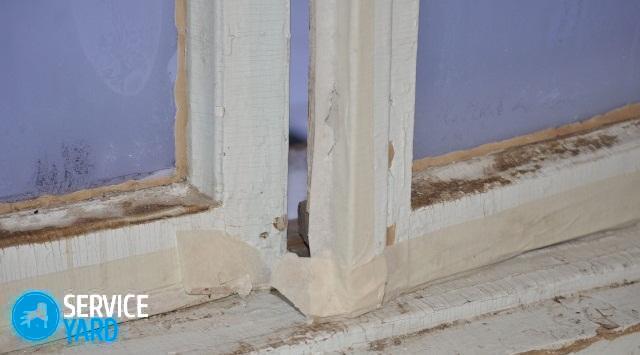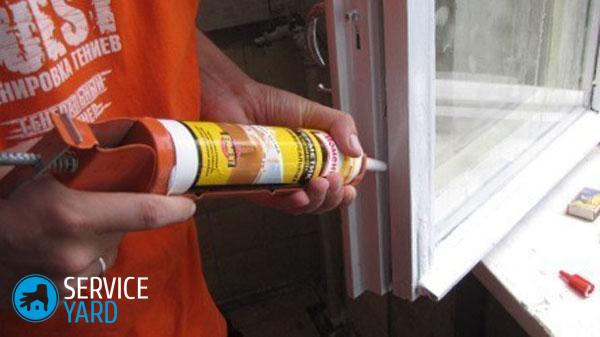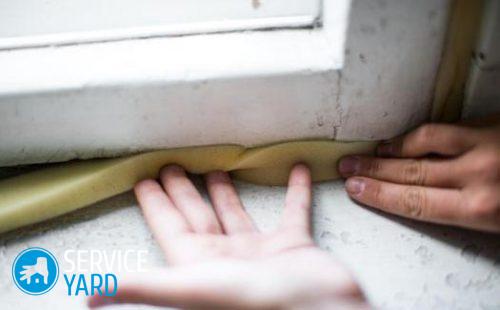How to insulate wooden windows for the winter?

- Bridges of cold - what is it and where are they?
- General rules of warming
- How to insulate wooden windows yourself?
- How to insulate windows with a sealant?
- How to insulate wooden windows with large gaps?
- How to insulate old wooden windows?
- An innovative method of warming window frames
- Helpful hints:
- Stock footage
With the onset of the cold period, we all begin to think about home insulation. To do this, we carry out central heating, construct underfloor heating and change windows. But the main thing during this period is to keep warm in the apartment, thanks to which we feel comfortable and cozy even in the most severe frosts. Most of the warm air leaves our house through the windows. In a house with beautiful wooden windows, an optimally comfortable microclimate is always maintained. Due to the unique properties of wood, the room breathes easily and freely, since such windows do not trap air, but allow it to circulate. However, wooden windows have one significant drawback - lower heat-saving qualities, but this problem can be solved. Today we will tell you how to insulate wooden windows for the winter in order to maintain a healthy microclimate in the room.
to contents ↑Bridges of cold - what is it and where are they?
The meaning of insulation is to create the most airtight internal air space between the frames. Everyone knows that air is an excellent heat insulator, only if it is enclosed in an enclosed space. This space is the distance between the inner and outer frame.
Hence the conclusion: to insulate the windows, it is necessary to eliminate all the gaps that allow cold streams to get from the street into the house.
Where does the cold air come from?
Regardless of the condition of the wooden structure, it has several bridges of cold, that is, ways of penetration of flows from the street. And if one is insulated, and the other is not eliminated, then one can not count on heat conservation. Therefore, before the arrival of winter, examine the entire wooden structure, from the frame, glass and to the windowsill for the presence of places of penetration of cold. In particular, examine:
- Windowsill.
- Glass.
- Slopes.
- Jumpers over the windows.
- Cracks in the frames.
General rules of warming
Let us consider in more detail how to insulate wooden windows for the winter. To keep the house warm, listen to the following recommendations and tips.
Jumpers
Wrap jumpers outside the building. Use facade building polystyrene for this purpose. Glue it to the opening. You can, of course, protect yourself from the cold from the inside, but in this case you will have to build a decorative cornice or box.
Slopes
Slopes can also contribute to heat loss, so pre-sand and prime the side planes. Install special PVC elements, filling the voids inside with natural tow or polyurethane foam.

Windowsill
In 30% of cases, the greatest amount of heat leaves through the windowsill, if it was originally installed incorrectly or as a result of prolonged use. For example, a common reason - the cement-sand layer in the brickwork gave internal cracks. Therefore, when revealing through gaps, cover them with foam on the outside, but do this not in the winter, but long before the cold weather.
Frames
Cracks in old frames can also be conductors of cold. To eliminate them, treat the indentations with putty on wood and sand after drying.After puttying, cover the frame with enamel or varnish.
You can also use sealant to isolate the cracks: fill the cracks with molten paraffin and fill them with a solution of flour and sand in a 3: 1 ratio. After the mixture has hardened, paint over the frame.
Glass
Glass also needs to be prepared for the cold season. Wash the windows clean and dry with a soft cloth or crumpled newspaper. The next stage is the gluing of a transparent film with a high reflectivity of infrared rays. It is possible to block not only glass, but also frames with a special film. You can attach the material with double-sided tape or a stapler to the frame.
to contents ↑How to insulate wooden windows yourself?
To insulate the wooden windows for the winter with their own hands, they usually eliminate the gaps around the perimeter of the window and the narthex gap. For these purposes, use a variety of materials - both traditional and modern. At the same time, the thermal insulation technology itself is also different. Let's consider in more detail how this or that material is used.
Paper
It is used as a driving hole, which allows you to insulate wooden windows:
- Soak small pieces of paper (newspaper, toilet paper) in water and grind to a pulp consistency.
- Fill the inter-frame slots with a mixture using a knife, a screwdriver or a metal ruler.
- After the paper has dried, stick masking tape or paper tapes on top using a flour paste.
- You can also use fabric tapes for insulation by sticking them with a soap solution.
Important! The advantage of the latter option is the ease of dismantling, in addition, frame paint is not damaged from this type of insulating material.
Foam rubber
This material is affordable, inexpensive, and easy to dismantle. And you will spend a little time on insulating wooden windows for the winter with this material. The method is effective for old windows with weak coloring. Glue fabric or paper strips over the foam.
Important! Choose a foam rubber of such a thickness that it fits tightly into the gaps. Otherwise, cold air will still leak through it.
Tube profiles
Sealing gaskets are modern materials with a service life of 5 years, so they are used not only for winterizing windows. Fill the perimeter of the window frame with insulation and you can not remove it for the summer.
You can use gaskets from the following materials:
- Rubber.
- Polyurethane.
- Polyethylene foam.
- Foam rubber.
- Polyvinyl chloride (PVC).
Important! The most frost-resistant are PVC profiles, and the better and more durable ones are made of rubber. When buying rubber seals, pay attention to the fact that they are both self-adhesive and require special glue. When choosing a rubber version of a tubular profile, give preference to a softer material.
Depending on the width of the gaps, choose the type of profile:
- D - for wide slots.
- E - for narrow.
- P - for medium.
to contents ↑Important! It is impossible to work with a tubular profile in winter. The procedure “pasting windows” is carried out in the first months of autumn, at an air temperature of at least +10 degrees.
How to insulate windows with a sealant?
The insulation technology depends on the material of the profile, as well as on whether self-adhesive material is used or if special glue is needed.
Of course, working with a self-adhesive profile is easier. In the process, you only need to pay attention to the accuracy of placement and eliminate creases and gaps. However, such a heater quickly loses its performance and will last the whole season. In addition, traces of glue are difficult to remove, and sometimes - you have to resort to a new painting of the frame.
The second option is much more reliable, but glue or sealant is needed to use it.

To insulate wooden windows for the winter in this way as follows:
- Clean the frames from dust, dirt and peeling paint.
- Sand the surface, degrease.
- Glue the seal in one or several parallel rows on the open window sash.
- Use a self-adhesive profile at the edges with small nails.
- Carefully close the frame to lock it.
- Mount the tape on all perimeters, including the window and sash.
- Glue the seal evenly so that the transom can open easily.
How to insulate wooden windows with large gaps?
If the frames are skewed or too old, it is almost impossible to cover the slots with sealing tape.
Method 1
In this case, you will have to use cotton wool, foam rubber, rags or paper to caulk huge gaps, and then putty them with special mixtures.
Carry out the process in such a way as to insulate wood windows for the winter with high quality:
- Prepare the windows: wash them, wipe dry.
- Close the external frame on the latch.
- Foam or rags cut into long strips.
- Using a thin knife (screwdriver) and insulation strips, seal the gaps between the outer frames and the window frame.
- Close the internal frames on the latch.
- Similarly trample the cracks in the inner frames.
- Glue on top with masking tape (paper or cloth).

Method 2
A more radical method of qualitative insulation of windows and cracks in the windowsill is the use of building mixtures: putty on a glue basis, a solution of alabaster and chalk (in a ratio of 1: 1), window sealants. Apply the selected mixture to the slots with a metal spatula and leave to dry completely. This method is effective for old frames that cannot be insulated with sealing tape.
Method 3
If you do not plan to never open a window, then you can use mounting foam to insulate wooden windows:
- Fill the gaps with it and wait for the foam to expand and solidify.
- Cut off excess with a sharp knife.
to contents ↑Important! So that the foam does not yellow and does not collapse, cover it with white enamel.
How to insulate old wooden windows?
In worn-out structures, cracks between frames and glass form over time. The thermal insulation technology of this design is akin to restoration and is a rather labor-intensive process. So think, maybe you should just install new windows? If you are not ready to part with the current structures and are ready to do all the work yourself, proceed in accordance with the instructions below to insulate wooden windows, the condition of which is pretty deplorable.
Tools and materials:
- New wooden glazing beads (thin slats holding glass).
- Sealant.
- Thin screwdriver or small knife.
- Protective gloves.

Thermal insulation technology:
- Remove the window shutter from the hinges.
- Use a thin screwdriver or small knife to remove the old glazing beads.
- Put on gloves.
- Remove the glass.
- Carefully clean the grooves in the frame from dust, dirt and old putty.
- Remove the putty from the glass using any alkaline solution, for example, soda ash.
- Wait for the tree to dry.
- Fill the transparent silicone sealant with the grooves in the frame.
- Install the glass.
- Carefully hammer in the new glazing beads with window studs.
- Seal the remaining slots with sealant.
- Remove excess with a damp cloth.
- Repeat the procedure with all glasses.
- Allow windows and sealant to dry for 2-4 hours.
- Wipe the windows with a glass cleaner.
- Proceed to warm the frames.
to contents ↑Important! The procedure for dismantling glazing beads from glass begins with the lower rails, then the side rails, and then the upper ones. Buy beads with a margin, as they are very fragile and can break during operation.
An innovative method of warming window frames
In recent years, Swedish window insulation technology has become increasingly popular. The methodology is based on the use of a special tubular silicone sealant.
Properties and characteristics:
- Designed for temperature differences from -50 to +80 degrees.
- The sealant is made in Sweden (hence the name of the method) and, according to the manufacturers, its service life is at least 20 years.
- The tape is made of a special material, which is based on: rubber and silicone.
- The sealant is a tubular profile that is mounted in a slot in the frame.
- Depending on the width of the gap, choose the right size of the gasket: 5, 6, 8, 10 or 12 mm.
Advantages of the Swedish method:
- Practicality.
- High strength.
- High rate of thermal conductivity. After insulation, wooden windows give the same level of heat savings as sealed double-glazed windows of plastic euro-windows.
- There is no need to seal windows for the winter.
- The cost of thermal insulation is 2-3 times cheaper than a plastic euro-window.
- Condensation does not appear on the glasses, unlike glass packets.
- Specialists are able to insulate a wooden window for three hours.
- The tubular seal is immune to external factors, including mechanical ones.
Disadvantage:
DIY installation is almost impossible. During installation, you need a profile tool (a special mill), specific work skills, since the Swedish technology is difficult to conduct the process with your own hands.
Technology Features:
In frames, grooves are cut from all sides with a mill, into which a sealant is inserted, which takes the desired shape.
to contents ↑Helpful hints:
- When choosing a method of insulation, be sure to evaluate the condition of the windows themselves, calculate the cost of the necessary materials. Simultaneously with the warming process, carry out ongoing repairs, for example, change the fasteners, eliminate rotten areas and old putty, sand cracks.
- Do not seal the outer frame with vapor-proof tape so that there is no fogging of the window, and freezing in frost. Seal only the inner frame to prevent moisture from entering the space between the frames.
- If the humidity in the house is increased, then put an adsorbent between the frames: silica gel, soda or salt. In order not to spoil the appearance of the window, place the adsorbent in a small package of white paper.
to contents ↑Stock footage
We hope that our tips have helped you to insulate wooden windows without much cost and effort. So - now coziness and comfort reign in the house, and in your soul - warmth and joy.
- How to choose a vacuum cleaner taking into account the characteristics of the house and coatings?
- What to look for when choosing a water delivery
- How to quickly create comfort at home - tips for housewives
- How to choose the perfect TV - useful tips
- What to look for when choosing blinds
- What should be running shoes?
- What useful things can you buy in a hardware store
- Iphone 11 pro max review
- Than iPhone is better than Android smartphones



